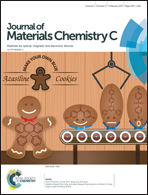Pore-size-tuned host–guest interactions in Co-MOFs via in situ microcalorimetry: adsorption and magnetism†
Abstract
Supramolecular interactions are fundamental to host–guest binding in many chemical and biological processes. Based on the direct quantification of such supramolecular interactions within metal–organic frameworks (MOFs), the interactions can be controlled through a flexible structural response to guests. We report a flexible Co-MOF [Co3(OH)2(L)2]·4H2O (1·4H2O, H2L = benzotriazole-5-carboxylic acid), which is liable to undergo structural transformation into [Co3(OH)2(L)2]·EtOH (1·EtOH) by pore breathing. Herein, a new strategy is developed to encapsulate more guest molecules of larger size into the Co-MOF via thermodynamics-directed de novo assembly of metal ions, organic linkers and the expected guest molecules by in situ microcalorimetry. As exemplified by the self-assembly of two N,N-dimethyl formamide (DMF) molecules into a Co-MOF, [Co3(OH)2(L)2]·2DMF (2·2DMF) was solvothermally attained at higher temperature, resulting in the elongation of the crystal unit via the b axis during the reconstruction of the framework and the dramatic change in the Co–O bond length and the Co–O–Co angle. Notably, for 2·2DMF, the calculated Langmuir surface area is nearly 5 times more than those of 1·4H2O and 1·EtOH, in agreement with the result of distorted cavities. Due to the two DMF molecules in the cavity, 2·2DMF displays excellent capability for the capture of Cr(VI) from wastewater by the formation of a new electrostatic interaction between the oxygen of the carbonyl from DMF and Cr(VI). Moreover, the fitting results of magnetic data show that the value of J2 in 2·2DMF is greater than that in 1·4H2O, which implies that ferromagnetic coupling increases. Our observations demonstrate that a detailed understanding of subtle intermolecular interactions between the framework and the guest can be used to induce changes to a different extent in the active (adsorption and magnetism) properties of a supramolecular network.



 Please wait while we load your content...
Please wait while we load your content...